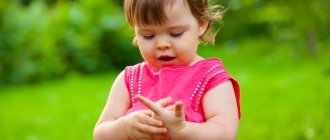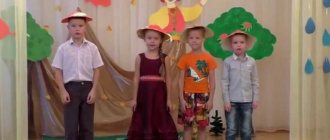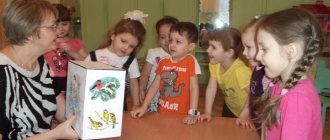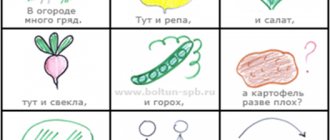Development of children's speech through oral folk art article on speech development (junior group)
Development of children's speech through oral folk art
Currently, along with the search for modern models of education, the best examples of folk pedagogy are being revived. I believe that folklore is one of its most effective and vibrant means, fraught with enormous didactic opportunities. Also K.D. Ushinsky emphasized that “the wisdom of ancestors is a mirror for descendants,” and therefore advocated public education, because it is a living example in the process of moral development.
The problem of developing children's speech through small forms of folklore today is of particular importance. At an early age, it is very important to accelerate the “birth” of the child’s first conscious words. Small forms of folklore help to increase the stock, in which one’s attention is drawn to objects, animals, and people. The sonority, rhythm, melodiousness, and entertaining nature of folk works attracts children’s attention, makes them want to repeat them and remember them, which in turn contributes to the development of spoken language.”
She began her work by studying methodological literature. The following manuals seemed most interesting to me: L.N. Pavlova “Early childhood: development of speech and thinking”; K. Belaya “Activities with kids in kindergarten.” The work was based on the scientific achievements of A.P. Usova “Russian folk art in kindergarten”, E.A. Flerina “Aesthetic education of preschool children.” The articles of Candidate of Psychological Sciences L.N. helped us select the most successful methods of influencing children. Pavlova “Folklore for kids.” In my activities I rely on the comprehensive lessons of T.M. Bondarenko, since they include a large content of folklore material. Children's folklore is a vast area of oral folk art. This is a whole world - bright, joyful, filled with vitality and beauty. For centuries, people selected and preserved, passed on from mouth to mouth these small masterpieces, complete
With the help of small forms of folklore, it is possible to solve almost all problems in the methodology of speech development, and along with the basic methods and techniques of speech development of preschoolers, this rich material of verbal creativity of the people can and should be used.” These are the first works of art that a child hears. They are varied in content: lullabies are soothing, funny ones are pleasing, they convey love for the child and care for him. Getting to know folk nursery rhymes broadens children's horizons, enriches their feelings and speech, and shapes their attitude towards the world around them.
The development of children's speech through folklore works, of course, does not manifest itself. The teacher plays an important role in this, skillfully guiding this process. Therefore, in my work with children, I set myself
goal: to use works of Russian folklore as an opportunity to develop the speech of young children; to make children's lives interesting and meaningful, to fill it with vivid impressions, the joy of creativity, and the ability to know themselves and the world around them.
Tasks:
- mastering spoken language;
- expansion of vocabulary;
- education of sound culture of speech;
- formation of coherent speech;
- expand children's understanding of different forms of folklore;
- cultivate a love for folk art and folk traditions;
- ensure the formation of goodwill and communication;
- establish two-way contact with the baby during the adaptation period;
- bring joy to children and enrich them with new emotional impressions.
In her work on the development of children’s speech through works of folk art, she chose the following directions:
- in teaching correct pronunciation;
- in introducing children to Russian national culture;
- in direct educational activities;
- in conversations;
- in observations;
- in folk outdoor games;
- in games to develop fine motor skills;
- in theatrical activities.
I work with children of younger age groups. Just reading nursery rhymes creates favorable conditions for emotional contact with children. They become quiet, smile, ask
Development of speech with the help of Russian oral folk art
“To lead a speech is not to weave bast shoes” is an old Russian proverb. Speech is nature’s priceless gift to man. People interact through speech. In our modern world, the Russian language has become depleted and many folk words and expressions have been lost. Alexander Isaevich Solzhenitsyn believed that our modern oral and written speech is noticeably impoverished, becoming poor, inexpressive, and at the same time we are unjustifiably abandoning still viable, full-blooded words that are in danger of premature death.
The Russian language is also clogged with foreign words. Remembering and honoring your language is the responsibility of every person. The issues of developing correct speech in children are very relevant. Thanks to speech, children learn about the world around them, accumulate knowledge, and expand their range of ideas about objects. Using speech, they express their needs, talk about their feelings and experiences. Society feels the need to ensure that from the first years of a child’s life he is introduced to folk culture and universal human values to help enrich the spiritual world of preschool children.
The children stopped reading. TV, video, computer absorb the child, conquering the reserved corners of his consciousness and soul. V. Sukhomlinsky said: “Reading in childhood is primarily the education of the heart, the touch of human nobility to the innermost corners of the child’s soul.” Speech development is becoming an increasingly pressing problem in our society.
A fairy tale is a beautiful creation of art. The social, artistic and pedagogical value of folk tales is undoubted and generally recognized. Russian folk tale is a soil that has unlimited developmental and educational possibilities. It introduces children to the circle of extraordinary events, transformations that occur with their heroes, expresses deep moral ideas, teaches kind attitude towards people, shows high feelings and aspirations.
A fairy tale for a child is nothing more than a special means of comprehending life, a way of knowing, comprehending certain life phenomena, the moral attitudes of society, and comprehending reality. The imagery of a fairy tale, and even more so its conventions, is well absorbed by a child.
One of the principles of preschool education is the introduction of children to sociocultural norms, traditions of the family, society and state. The use of small forms of folklore in working with children helps to implement this principle of preschool education, outlined in the Federal State Educational Standard for Preschool Education. The standard also outlines the main directions in the development and activities of children. And one of these areas is speech development. In the course of mastering small folklore genres, speech improves, the child’s vocabulary is easily and naturally activated, the sound culture of speech and its intonation structure are improved. Children gain experience in social behavior, and their attitude towards the world around them is formed, because every piece of folk art has a moral orientation. Children's folklore is close and understandable to the child, lies deeply in his nature, is reflected spontaneously, because it is associated with play. Getting to know them plays an invaluable role in the comprehensive development and is the bearer of the cultural traditions of the people.
She began her work with the younger group. After the diagnosis, it became clear that modern children have almost no speech. I have a hypothesis that modern parents communicate little with their children. And Russian folklore is very accessible to children, they respond emotionally and this is the best way to quickly establish contact with a child during adaptation. After all, Russian nursery rhymes radiate warmth and kindness, and children immediately feel it.
In my work with preschoolers, I used various folk games, nursery rhymes, jokes, finger games, counting rhymes; they helped consolidate and enrich vocabulary, form and change words, practice composing coherent statements, and develop explanatory speech. They also actively studied Russian folk tales, using not only reading, but also theatrical activities. Various types of theaters were actively used: finger theater, tabletop, puppet theater, spoon theater, clothespin theater, flannelgraph theater, mask theater, life-size puppet theater, which helps to form children’s knowledge about Russian folk tales; cultivate interest in Russian folk art; instill a love for books; develop speech, activate vocabulary; develop creativity, fantasy, imagination.
In implementing the assigned tasks, I adhered to the following principles and methods:
- accessibility (simplicity, compliance with age and individual characteristics);
- visibility (illustrativeness, availability of didactic materials);
- democracy and humanism;
- scientific character (validity, presence of a methodological basis and theoretical basis);
- "from simple to complex."
Methods:
- - verbal (oral presentation, conversation, story);
- — visual (display of multimedia, illustrations, observation, demonstration of the teacher’s performance, work based on a model);
- - practical (verbal activity of children in the game).
At the beginning of the year, I drew up a plan for self-education and a plan for working with children, which was implemented during the school year, and also worked with parents. Various consultations and questionnaires were conducted for them.
Along with this, I attended open classes with colleagues in our kindergarten and RMOs in other kindergartens in our area.
I periodically updated didactic material for working with children on this topic.
In the course of systematic work, children:
- We learned to listen carefully and remember nursery rhymes, short works of art, riddles;
- We learned to play folk games and dance in circles.
- They formed ideas about small folklore genres.
- Activated vocabulary.
In my work, I decided to use interactive books on fairy tales, sewn with my own hands; this further increased the children’s interest, because they could touch, examine everything, take part in the performance themselves, and feel like heroes and just play. In play, the child reveals himself and learns to feel like an “adult”, and, therefore, tries on the role of an adult. I made the following books: “Teremok”, “The Wolf and the Seven Little Goats”, “The Ryaba Hen”, “Kolobok”. “Turnip”, as well as interactive books on sensory development. Collections of finger theaters and fairy tales for flannelgraph, as well as theater on mittens and life-size theater.
In all regime moments I used Russian folk nursery rhymes, sayings, signs, and riddles. This practice gave a great impetus to the development of children. Children have acquired the necessary knowledge, skills and abilities. Pupils learned to actively accompany play and everyday actions with speech, use antonym words, form new words by analogy with familiar words, talk about the content of a plot picture, and with the help of an adult, repeat examples of describing a toy. And besides, I believe that it is very important to revive Russian traditions and cultivate spiritual and moral-patriotic feelings in children, because it is in traditions and customs that it is laid down what our future generation will be like, because children are the future of our country and are now in our power make this future better.
[mailerlite_form form_id=4]
On the role of oral folk art in raising children
Nasibullina S.L., Kuryshova I.A. On the role of oral folk art in raising children // Sovushka. 2022. N 3 (17). URL: https://kssovushka.ru/zhurnal/17/ (access date: 01/29/2022).
Order No. 400279
“The spiritual life of a child is complete only when he lives in the world of games, fairy tales, music, and fantasy. Without this, he is a dried flower."
V.A. Sukhomlinsky
The importance of works of oral folk art in the process of education and development of a preschool child is great. Folklore is a source of pedagogical influence on preschoolers, the basic basis for the education of morality, aesthetic feelings, and patriotism. In the process of its development, there is a huge impact on the emotional and moral spheres of the child [1, p.4].
The functions of educating oral folk art are that it promotes the understanding of such categories as good-evil, generosity-greed, honor, modesty, duty, etc. Russian folklore is comparable to a pure spring, after drinking from which a child gets to know his native people in his heart, becomes the spiritual heir of his traditions, which means he grows up to be a real person [1, p.7].
Already at an early age, a child encounters nursery rhymes, which represent one of the small forms of folklore works. For the child, the semantic content, the rhythm of words, and the ability to perform various actions when pronouncing the text become important. He experiences an emotional outburst, and this also helps to change his behavior, especially during the period of getting used to the conditions of being in kindergarten. With the help of a nursery rhyme or folk song, you can switch the child’s attention to some toy, evoke positive emotions towards the teacher, develop a sense of the need to perform such routine moments as sleeping, washing, combing one’s hair, eating, etc.
A fairy tale is a special means of educating a preschooler’s morality. She helps to demonstrate that friendship can overcome evil, that evil is always punished, and good deeds are always rewarded. Usually, positive heroes of fairy tales have character traits and intellectual abilities that are more valuable to a person. The child learns to evaluate the actions of positive and negative heroes, to find ways to help and protect the deceived and offended. Thanks to fairy-tale heroes, the child begins to understand what he should strive for and what actions to perform. Fairy tales always contain a lesson that the child learns for himself. Moral education is possible through all types of folk tales, because morality is initially inherent in their plots [3, p.31]. According to K.I. Chukovsky, a fairy tale improves, enriches and humanizes the child’s psyche, since the child feels like an active participant in it and always identifies himself with one of its characters fighting for good. This sympathy of children for the heroes of a fairy tale lies the main educational meaning of a fairy tale” [12].
In addition, based on the plot of a fairy tale, one can teach the basics of life safety, introduce dangerous aspects that can await a child in real life, and also draw parallels with reality [5, p. 124].
Works of oral folk art are a special means of forming and nurturing patriotic feelings in preschool age. They contain specific facts and images of heroes that arouse children's interest. A special place here is occupied by heroic tales, which tell about the heroic deeds of characters during the liberation of their people, their native land from enemies and evil spirits. K.D. Ushinsky considers children’s interest in various works of folklore as “an indicator of an emerging feeling of love for their native land, its history, nature, and people’s work” [7, pp. 13, 16, 17].
It is impossible not to note the importance of oral folk art for the formation of cognitive interest. “Fairy tales, depending on the topic and content, make listeners think and make them think. Often a child concludes: “This doesn’t happen in life.” The question involuntarily arises: “What happens in life?” Already the conversation between the narrator and the child, which contains the answer to this question, has educational significance. But fairy tales also contain educational material directly. It should be noted that the educational significance of fairy tales extends, in particular, to individual details of folk customs and traditions and even to everyday trifles” [2, p. 122]. For example, the Russian folk tale “Kolobok” introduces children to traditional Russian cuisine, the recipe for making kolob, and concepts such as “barn”, “susek”, “yarn”, thereby broadening their horizons and introducing them to the origins of the Russian language [16, p.24, 26].
Folklore reveals all the delights of the Russian language and enriches the speech of a preschooler. According to K.D. Ushinsky, “folklore texts awaken to life the seeds of the native word, which are always rooted, albeit unconsciously, in the soul of a child” (8, p. 298). Works of folklore allow a child to immerse himself in the beauty of his native language and influence the imagery of speech. Even the great children's writer K.I. Chukovsky in his book “From Two to Five” said that “all kinds of folk songs, fairy tales, proverbs, sayings, riddles, which constitute the favorite mental food of preschoolers, best introduce the child to the basics of folk speech” [12 ].
In works of oral folk art that influence environmental education, the connection between man and nature is very clearly visible. This is how numerous proverbs reflect observations of natural phenomena and their power. Round dance is an action that is completely connected with nature. Thus, nurturing love for native nature can also be based on folk pedagogy [4, pp. 42-44].
In addition to works of Russian folklore, works of folklore of the peoples of the world should also organically fit into a preschooler’s reading circle, which introduce the child to national cultures, instilling him in universal values. By comparing the works of different nations, the child gets the opportunity to make an initial analysis of national characteristics, which contributes to the understanding of common moral positions and common goals of the folklore of each nation [7, p.16].
In conclusion, we emphasize once again that the role of folklore in raising a child is limitless. Oral folk art has an educational effect on the development of personality, feelings, character traits that connect a child with his people through songs, games, dances, fairy tales, etc. This is a source of pedagogical material, the basis of speech, moral, aesthetic, patriotic, and environmental education. Using the heritage of the people in work enlivens the pedagogical process.
Literature:
- Vikulina A.M. Elements of Russian folk culture in the pedagogical process of a preschool institution. N. Novgorod: Nizhny Novgorod Humanitarian Center, 1995. 138 p.
- Volkov G.N. Ethnopedagogy: textbook. for students avg. and higher ped. textbook establishments. M.: Academy, 1999. 168 p.
- Zimina I. Folk tale in the system of education of preschool children // Preschool education. 2005. No. 5. pp. 28-35.
- Nikolaeva S. On the possibilities of folk pedagogy in the environmental education of children // Preschool education. 2009. No. 4. P.42-46.
- Pidruchnaya S. Fairy tales - for the safety of children // Preschool education. 2008. No. 2. pp. 124-127.
- Poshtareva T. The use of folk tales in the educational process // Preschool education. 2009. No. 5. pp. 24-28.
- Ushinsky K.D. Native word. Collected Works, M.: 1974.
- Ushinsky K.D. Collected works. T.6. M., 1948.
- https://nsportal.ru/detskiy-sad/razvitie-rechi/2017/09/05/rol-ustnogo-narodnogo-tvorchestva-v-vospitanii-detey
- https://infourok.ru/rol-ustnogo-narodnogo-tvorchestva-v-vospitanii-detey-mladshego-doshkolnogo-vozrasta-1906816.html
- https://moluch.ru/archive/179/46317/
- Chukovsky K.I. From two to five. URL: https://www.gumer.info/





